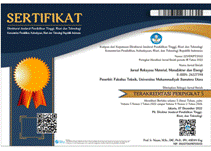Pengaruh Putaran Spindle Dan Bahan Spesimen Terhadap Gaya Potong Pada Proses Pemesinan Turning
Abstract
The turning Machining Process is one of the most commonly used machining processes in the industrial world, both in large-scale industries and small industries (home industries). The turning machining process is a process of changing the shape of the material by removing some of the material in the form of swells. During the machining process, there is an interaction between the tool and the workpiece specimen being cut which results in a change in the cutting force. The value of the cutting force is important information in research, this study aims to see the cutting force during the turning machining process using 2 different types. The research data collection method uses sensor tools, there are three sensors, namely the load cell sensor for cutting force, the photoelectric counter module for rotation (rpm), and the thermocouple for feeding temperature. The research variable used is the rotational speed of rpm starting from 90, 110, 150, and 190 rpm, the depth of cut is 0.3 mm. The cutting force generated on the DCGT insert chisel is 5.94N at 90 rpm, 4.13N at 110 rpm, 2.38N at 150 rpm, and at 190 rpm the DCGT chisel gets a force of 2.03N. Furthermore, the cutting force that occurs on the DCMT insert chisel is 2.94N at 90 rpm, 2.67N at 110 rpm, 2.61N at 150 rpm, and at 190 rpm the DCMT insert chisel gets a force of 2.51N. It can be concluded that the decrease in cutting force is influenced by the amount of rpm used, and the magnitude of the cutting force is due to vibrations that occur in the specimen caused by low rpm.
Keywords
Full Text:
PDFReferences
A. R. Nasution, Z. Fuadi, I. Hasanuddin, and R. Kurniawan, Effect of vegetable oils as cutting fluid on wear of carbide cutting tool insert in a milling process, IOP Conf. Ser. Mater. Sci. Eng., vol. 796, no. 1, pp. 010, 2020, doi: 10.1088/1757-899X/796/1/012001.
H. M. Rizal1*, J.A. Ghani2, Husni1, Design and construction of a strain gauge-based dynamometer for a 3-axis cutting force measurement in turning process, J. Mech. Eng. Sci., vol. 12, no. 4, pp. 40724087, 2018,
doi: https://doi.org/10.15282/jmes.12.4.2018.07.0353.
A. R. Nasution and W. S. Damanik, Analisa Gaya Potong Pada Proses Pemesinan Menggunakan Bahan Politetrafluoroetilena ( PTFE ), Dep. Mech. Eng. Univ. Muhammadiyah Sumatera Utar, pp. 649658, 2021.
A. R. Nasution, R. Rahmatullah, and J. Harahap, Pengaruh Variasi Putaran Spindel Terhadap Gaya Potong Pada Proses Pemesinan, VOCATECH Vocat. Educ. Technol. J., vol. 2, no. 2, pp. 9299, 2021, doi: 10.38038/vocatech.v2i2.56.
S. H. Affandi, Ahmad Marabdi Siregar, Chandra A Siregar, Arya Rudi Nasution, Iqbal Tanjung, Syarizal Fonna, Analisa Korosi Atmosferik Baja Karbon Rendah Di Kecamatan Medan Belawan, Multitek Indones., vol. 6223, no. 2, pp. 8088, 2020.
S. Huzni, Affandi, I. Tanjung, and S. Fonna, Atmospheric corrosion map of structural steel in industrial area: A preliminary investigation, IOP Conf. Ser. Mater. Sci. Eng., vol. 602, no. 1, 2019, doi: 10.1088/1757-899X/602/1/012075.
S. Kalpakjian, Manufacturing Engineering & Technology, Sixth. 2009.
A. . Nasution, A. R, Affandi Affandi, Khairul Umurani, A. M., Siregar, Analisis Kekasaran Permukaan Cast Iron Menggunakan Cairan Pendingin Berbasis Nabati Pada Proses Face milling, J. Rekayasa Mater. Manufaktur dan Energi http//jurnal.umsu.ac.id/index.php/RMME, vol. 4, no. 2, pp. 125131, 2021.
C. Scheffer and P. S. Heyns, An industrial tool wear monitoring system for interrupted turning, Mech. Syst. Signal Process., vol. 18, no. 5, pp. 12191242, 2004, doi: https://doi.org/10.1016/j.ymssp.2003.09.001.
K. Umurani, A. M., Siregar, and S. Al-Amin, Pengaruh Jumlah Sudu Prototype Pembangkit Listrik Tenaga Mikrohidro Tipe Whirlpool Terhadap Kinerja, J. Rekayasa Mater. Manufaktur dan Energi, vol. 3, no. 2, pp. 103111, 2020,
doi: 10.30596/rmme.v3i2.5272.
V. P. Astakhov, The assessment of cutting tool wear, Int. J. Mach. Tools Manuf., vol. 44, no. 6, pp. 637647, 2004, doi: https://doi.org/10.1016/j.ijmachtools.2003.11.006.
X. Xu, J. Wang, B. Zhong, W. Ming, and M. Chen, Deep learning-based tool wear prediction and its application for machining process using multi-scale feature fusion and channel attention mechanism, Measurement, vol. 177, p. 109254, 2021, doi: https://doi.org/10.1016/j.measurement.2021.109254.
M. Iqbal, T. F. Ariff, M. S. F. bin Mat Roseh, M. H. F. Al-Hazza, I. Hilmy, and Suryanto, Effect of Microwave Sintering Treatment to the Flank Wear of Titanium Carbide Tools in Milling Operations, Adv. Mater. Res., vol. 1115, no. June 2016, pp. 5963, 2015, doi: 10.4028/www.scientific.net/amr.1115.59.
R. K. Bharilya, R. Malgaya, L. Patidar, R. K. Gurjar, and A. K. Jha, Study of Optimised Process Parameters in Turning Operation Through Force Dynamometer on CNC Machine, 2015, doi: 10.1016/j.matpr.2015.07.268.
T. Rochim, Proses Permesinan Buku 4: Perkakas & Sistem Pemerkakasan Umur Pahat, Cairan Pendingin Pemesinan. 2013.
J. R. Davis, General Guidelines for Selecting Cutting Tool Materials. 1995.
T. N. Projoth, D. P. M. Victor, and P. Nanthakumar, Analysis and prediction of cutting force through lathe tool dynamometer in CNC turning process, Mater. Today Proc., vol. 46, pp. 41744179, 2021, doi: https://doi.org/10.1016/j.matpr.2021.02.681.
ASTM, Standard Specification for Copper-Zinc-Lead Alloy ( Leaded-Brass ) Extruded Shapes 1, Astm, vol. 30, no. Reapproved 2017, pp. 13, 2015.
Tec h nical R eference Handb ook. 2018.
Nehemia Ratur Tarigan, Nurdiana, Mahyunis, supriadi. M.Kamil,Iswandi, Eswanto, " Perancangan Mesin Penghancur Bonggol Jagung Untuk Pakan Ternak Sapi Dan Kambing Kapasitas 100 Kg/Jam" Jurnal Rekayasa Material, Manufaktur dan Energi, Vol. 2, No. 1, Maret 2019, 54-63 DOI:https://doi.org/10.30596/rmme.v2i1.3069
ASTM E8, ASTM E8/E8M standard test methods for tension testing of metallic materials 1, no. C. 2010.
A. R. Nasution, Affandi., and Z. Fuadi, Pengaruh Cairan Pendingin Terhadap Kekasaran Permukaan Benda Kerja Pada Proses Face Milling, J. Rekayasa Mater. Manufaktur dan Energi, vol. 3, no. 1, pp. 1622, 2019, doi: doi.org/10.30596/rmme.v3i1.4524.
DOI: https://doi.org/10.30596/rmme.v5i1.10267
Refbacks
- There are currently no refbacks.

This work is licensed under a Creative Commons Attribution 3.0 License
Jurnal Rekayasa Material, Manufaktur dan Energi is abstracting & indexing in the following databases:
This work is licensed under a Creative Commons Attribution-ShareAlike 4.0 International License.
Statcounter View My Stats RMME














